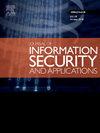Leveraging High-Frequency Diversified Augmentation for general deepfake detection
IF 3.8
2区 计算机科学
Q2 COMPUTER SCIENCE, INFORMATION SYSTEMS
Journal of Information Security and Applications
Pub Date : 2025-02-12
DOI:10.1016/j.jisa.2025.103994
引用次数: 0
Abstract
With the rapid advancement of deepfake technology, the visual quality of synthesized faces has significantly improved, raising serious security concerns about the misuse of facial manipulation techniques. As a result, deepfake detection has become a central focus within the multimedia forensics community. Recent studies have highlighted discrepancies between forged and genuine images in the high-frequency components. However, these studies have not fully addressed the inconsistency in high-frequency distributions across different datasets, which can lead to overfitting since models are trained on a limited range of high-frequency features. To overcome this challenge, we propose a High-Frequency Diversified Augmentation (HFDA) method designed to broaden the variation range of high-frequency features in training images. Specifically, our approach perturbs the amplitude spectra of the training data to generate augmented images with enhanced diversity in the high-frequency bands. Additionally, we introduce a forgery artifact consistency learning strategy to guide discriminative feature learning, aligning augmented images with their corresponding raw images. Extensive experiments demonstrate that the proposed HFDA method achieves superior or comparable performance to state-of-the-art methods across several widely used datasets. The code is available at https://github.com/laizhm/HFDA.
利用高频多样化增强技术进行一般深度伪造检测
随着深度伪造技术的快速发展,合成人脸的视觉质量有了显著提高,人脸操纵技术被滥用的安全问题也日益严重。因此,深度伪造检测已经成为多媒体取证界关注的焦点。最近的研究强调了伪造图像和真实图像在高频成分上的差异。然而,这些研究并没有完全解决不同数据集之间高频分布的不一致性,这可能导致过拟合,因为模型是在有限范围的高频特征上训练的。为了克服这一挑战,我们提出了一种高频多样化增强(HFDA)方法,旨在扩大训练图像中高频特征的变化范围。具体来说,我们的方法对训练数据的振幅谱进行扰动,以生成具有增强高频波段多样性的增强图像。此外,我们引入了一种伪造工件一致性学习策略来指导判别特征学习,将增强图像与其对应的原始图像对齐。广泛的实验表明,所提出的HFDA方法在几个广泛使用的数据集上取得了优于或与最先进的方法相当的性能。代码可在https://github.com/laizhm/HFDA上获得。
本文章由计算机程序翻译,如有差异,请以英文原文为准。
求助全文
约1分钟内获得全文
求助全文
来源期刊

Journal of Information Security and Applications
Computer Science-Computer Networks and Communications
CiteScore
10.90
自引率
5.40%
发文量
206
审稿时长
56 days
期刊介绍:
Journal of Information Security and Applications (JISA) focuses on the original research and practice-driven applications with relevance to information security and applications. JISA provides a common linkage between a vibrant scientific and research community and industry professionals by offering a clear view on modern problems and challenges in information security, as well as identifying promising scientific and "best-practice" solutions. JISA issues offer a balance between original research work and innovative industrial approaches by internationally renowned information security experts and researchers.
 求助内容:
求助内容: 应助结果提醒方式:
应助结果提醒方式:


